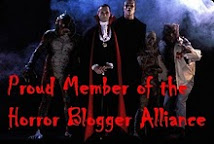It's football season again in America, which means there's an extra spring in The Mike's step. More annoyingly, it also means that The Mike's Lair - which lies just down the road from his alma mater's football stadium, needs to be cleaned a little more often. As I started to sweep up the remnants of the offseason from my living quarters this weekend, I couldn't help noticing how many books on genre flicks I happened to have lying around as reference materials. Normally I only bring books to FMWL when some kind soul offers me an interesting and free piece of literature, but it's not fair for me to keep all these sources of knowledge to myself now, is it?
Enter Monsters: A Field Guide to Blood-Thirsty Beasts, a glossy 200 page handbook which - according to an introduction written by Abraham Van Helsing in 1898 - "could save your life". The publisher's information inside the book states that it was first published in 2004, so I'm slightly confused as to what occurred in the 106 years between the fictional character's foreword and the publication of the book. I mean, there were generations of potential monster victims in that time span - I sure hope that they had something like this to help them out.
After the introductions and some brief instructions - including a tutorial on "Monster Behavior" and some information on the classification and location of these creatures - the book is broken up into several sections that segregate a horde of cinematic terrors into "classes" of sort. I guess that authors Dave Elliott, C.J. Henderson, R. Allen Leider didn't want to get all the monsters mixed up, so they've broken things up in to categories like "Mutated Lizards, Fish and Dinosaurs", "Monster Men", "Manufactured Monsters", and even "Mutated Vegetables". Each section offers a wide variety of creatures and villains that spans the history of film (and television, briefly), most of which receive a full page of the book that focuses on their traits and how us humans can deal with them.
With only part of a page available due to the large images, the authors keep their commentary on each creature brief, yet still cover a bit of information. There's a "tale of the tape" on each page, which breaks down things like the monster's size, habitat, intelligence (via a 1-5 brain rating scale), and film of origin. The location and size are also illustrated in diagrams on the page, which are summed up in other sections of the book. The text includes a description of the monster and comments on four key traits - Behavior, Lethality, Weaknesses, and Powers. Though the book is less thorough than many online bloggers (this is where I could shamelessly plug my own budding "So You Want To Be a Monster?" series), it provides a nice introduction that should help less experienced viewers to find some horror classics.
It should be noted that the book is not all horror either, as villains from many sci-fi classics and even a few comedies (including the really weird inclusion of 2000's The Little Vampire, which was released near the end of the Jonathan Lipnicki craze of the late '90s). It's interesting to see these characters included next to some of the classic horror and sci-fi stars we're used to reading about, yet the book still seems to miss a few rather important fellas. I'm not gonna name names, but let's just say that there's a certain amorphous pink killer from outer space who showed up in 1958 and terrorized Steve McQueen and who has become very near and dear to me who DOESN'T appear in the book. Yeah. I know. Sadness.
This field guide definitely proves it's not the most in depth resource for potential opponents of monsters out there - I gotta believe there's a full Oxford Dictionary sized reference book out there somewhere that really gets down to the nitty gritty of things - but it's a fun little "pocket guide" of sorts. Full-time horror fans might not learn much new from it, but the well-designed and visually appealing book is at least good for those who want to learn a little more about monster cinema. I've had the book - which I found on one of those tables at Borders where they put the marked down books they don't want any more - for over a year, and it's still good for a couple of reminders of movies I love or movies I meant to see every once in a while.
This book may have been a life saver in Professor Van Helsing's day, but today's horror fan has a lot of other resources at their fingertips too. I'm not sure I'd trust my life to the book, but it's still a fun little horror handbook that's well designed and provides some good lauhghs. If I ever run into Godzilla or Dracula or The Grim Reaper (as played by Bill Sadler in Bill & Ted's Bogus Journey), at least it won't take me long to read up on them. If you want that comfort - or if you know someone who could use the help - it's a super cheap pickup on Amazon. If the good professor is right, it's a solid investment in your future.
Winner Takes It All
4 days ago
















No comments:
Post a Comment